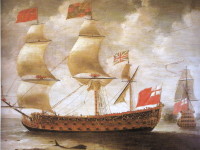The Prince Royal was an English battery ship, which was by several conversion to one of the largest warships of his time under the English flag and served in the Anglo-Dutch naval warfare as a flagship.
Launching and design:
The Prince Royal was built on the orders of English King James I and ran on July 25, 1610 from the stack. Before the first conversion measures the ship was equipped with 55 guns, which were distributed on 3 decks. Thus, the ship was the precursor of the three-decker battleships. Next lay between the fore and aft decks a Kuhl, which was to serve as a trap for enemy soldiers who wanted to board the ship. This was at the time construction, at the time already uncommon, put emphasis on protection against beaching.
At the beginning the ship was equipped with 4 masts, while one of the reconstruction measures was 1 mast removed.
The stakes during the Anglo-Dutch naval warfare:
Before the first use in a battle, the Prince Royal was rebuilt in 1641 and its armament increased to 70 guns. In addition, it was renamed Resolution.
The first naval battle took place on June 12, 1653 during the naval battle at Gabbard. There, the resolution was also used by Admiral Robert Blake for the first time as a flagship. Together with the ship Dolphin, the ship was surrounded during the battle by the Dutch, only with the arrival of the English rearguard a sinking could be averted. The Dutch had to withdraw from the battle.
On 10 August 1653, the next attack of the Dutch took place when they tried to break the English blockade in the English Channel. Due to high losses, damage and the death of the Dutch Fleet Commander Maarten Tromp, the Dutch withdrew again. The English also withdrew due to higher damage to their ships and dissolved the blockade.
Between 1660 and 1663 the next reconstruction took place in which the number of cannons was increased to 92, as well as the dimensions and tonnage. At the same time, the ship was classified as a first-rate ship and re-named Royal Prince (as this name was often used as Prince Royal).
During the second Anglo-Dutch naval war it came in June 1665 to a battle at Lowestoft, where the Royal Prince was used again as a flagship. For the first time she was boarded by the Dutch despite structural safety measures. Only by the aid of the Royal James, the Dutch could be expelled from the ship again. After the loss of 17 ships and about 5,000 sailors, the Dutch had to withdraw from this battle again.
The last naval battle in which the Royal Prince took part, took place on June 11, 1666 on the four-day battle off the coast of England. On 13 June, the retreat ordered by Admiral George Monck took place, leaving the Royal Prince stranded and thus unable to maneuver. After sighting Dutch Brander (firing ships) the crew stroked the flag and surrendered to the incoming Dutch fleet. On board the Dutch warship Gouda, Admiral Ayscue of the Royal Prince had to capitulate to Lieutenant-Admiral Cornelis Tromp. Subsequently, the ship was burned on the orders of Lieutenant-Admiral Michiel de Ruyter, so that the English could not conquer it back.

The capitulation of the run-down Royal Prince in the four-day battle. Painting by Willem van de Velde d. J., 1666
Ship data:
| Launching | 25. Juli 1610 |
| Country | England |
| Whereabouts | Burned on June 13, 1666 by the Dutch |
| Number of masts | 4, later 3 |
| Sails | Vollship, Royal sailing, topgallants |
| Length | 30 meters |
| Width | 14 meters |
| Draft | 5,4 meters |
| Displacement | 1187 metric tons |
| Arming | 55 cannons from 1641 70 - 80 cannons from 1663 92 cannons |
This post is also available in:
 Deutsch (German)
Deutsch (German)  Français (French)
Français (French)  Italiano (Italian)
Italiano (Italian)  简体中文 (Chinese (Simplified))
简体中文 (Chinese (Simplified))  Русский (Russian)
Русский (Russian)  Español (Spanish)
Español (Spanish)  العربية (Arabic)
العربية (Arabic)













